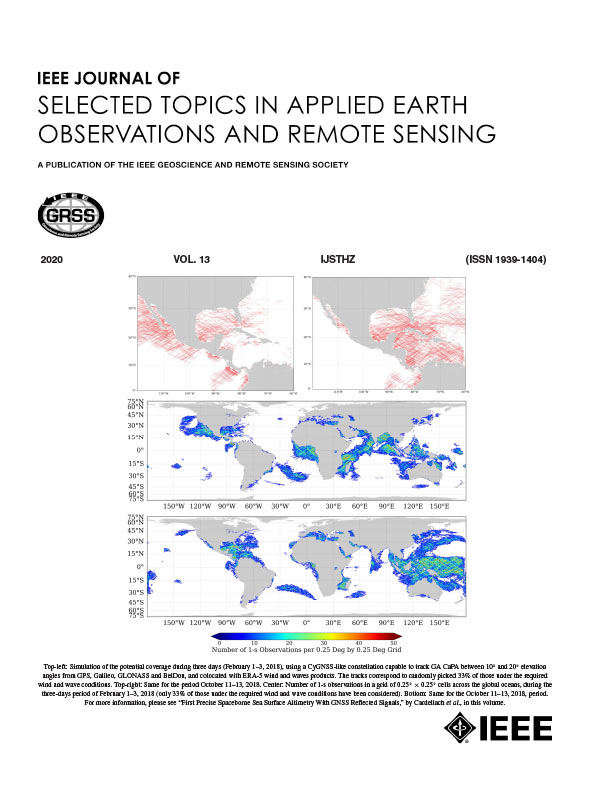GEO-LEO 双稳态合成孔径雷达的性能分析和系统设计
IF 4.7
2区 地球科学
Q1 ENGINEERING, ELECTRICAL & ELECTRONIC
IEEE Journal of Selected Topics in Applied Earth Observations and Remote Sensing
Pub Date : 2024-09-10
DOI:10.1109/JSTARS.2024.3457821
引用次数: 0
摘要
地球同步-低地轨道双稳态合成孔径雷达(GEO-LEO BiSAR)采用收发分系统形式,其中地球同步合成孔径雷达作为照明器,低地轨道合成孔径雷达作为接收器。GEO-LEO BiSAR 可以获得丰富的目标散射信息,实现大宽度成像,降低接收机成本。本文选取三个参数作为测量指标,全面评价系统性能,为系统设计提供指导。空间分辨率可以衡量成像性能,辐射分辨率是分辨物体散射特性的能力,波束覆盖面积代表系统观测能力。它们都是关键参数,与 BiSAR 配置密切相关。本文利用广义模糊函数和积分方程模型推导出 BiSAR 空间分辨率和辐射分辨率表达式,并通过几何知识推导出波束覆盖面积计算方法。这三个参数被建模为多目标优化问题系统设计的目标函数,其中基于分解和微分进化的多目标进化算法用于求解接收机轨道要素。我们可以联合优化这三个参数,同时考虑它们的值,也可以依次优化分辨率(空间分辨率和辐射分辨率)和覆盖范围。最后,通过仿真实验验证了分析的正确性。所提出的系统设计方法综合考虑了观测能力、分辨率和识别能力,可根据系统能力要求合理选择联合优化或顺序优化方案,以指导接收机轨道元素的选择。本文章由计算机程序翻译,如有差异,请以英文原文为准。
Performance Analysis and System Design in GEO-LEO Bistatic SAR
The geosynchronous-low-Earth-orbit bistatic synthetic aperture radar (GEO-LEO BiSAR) adopts the transceiver split system form, in which GEO SAR serves as the illuminator and LEO SAR serves as the receiver. GEO-LEO BiSAR can obtain abundant target scattering information, can realize large width imaging and reduce the receiver cost. Three parameters are selected as measurement indicators to comprehensively evaluate system performance and provide system design guidance. The spatial resolution can measure the imaging performance, the radiation resolution is the ability to distinguish the objects scattering characteristics, and the beam coverage area represents the system observation ability. They are all key parameters and are closely related to the BiSAR configuration. In this article, we use the generalized ambiguity function and integral equation model to derive the BiSAR spatial and radiation resolution expressions, and the beam coverage area calculation method is derived through geometric knowledge. These three parameters are modeled as objective functions for the system design of the multiobjective optimization problem, in which multiobjective evolutionary algorithm based on decomposition and differential evolution is used to solve the receiver orbital element. We can optimize these three parameters jointly considering their values or optimize the resolution (spatial and radiation resolution) and coverage area in sequence. Finally, the analysis correctness is verified by simulation experiments. The proposed system design method comprehensively considers the ability of observation, resolution and recognition, and can reasonably select joint or sequential optimization schemes according to the system capability requirements to guide the receiver orbital element selection.
求助全文
通过发布文献求助,成功后即可免费获取论文全文。
去求助
来源期刊
CiteScore
9.30
自引率
10.90%
发文量
563
审稿时长
4.7 months
期刊介绍:
The IEEE Journal of Selected Topics in Applied Earth Observations and Remote Sensing addresses the growing field of applications in Earth observations and remote sensing, and also provides a venue for the rapidly expanding special issues that are being sponsored by the IEEE Geosciences and Remote Sensing Society. The journal draws upon the experience of the highly successful “IEEE Transactions on Geoscience and Remote Sensing” and provide a complementary medium for the wide range of topics in applied earth observations. The ‘Applications’ areas encompasses the societal benefit areas of the Global Earth Observations Systems of Systems (GEOSS) program. Through deliberations over two years, ministers from 50 countries agreed to identify nine areas where Earth observation could positively impact the quality of life and health of their respective countries. Some of these are areas not traditionally addressed in the IEEE context. These include biodiversity, health and climate. Yet it is the skill sets of IEEE members, in areas such as observations, communications, computers, signal processing, standards and ocean engineering, that form the technical underpinnings of GEOSS. Thus, the Journal attracts a broad range of interests that serves both present members in new ways and expands the IEEE visibility into new areas.

 求助内容:
求助内容: 应助结果提醒方式:
应助结果提醒方式:


